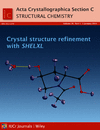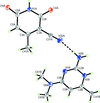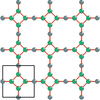issue contents
January 2015 issue

Cover illustration: Recent developments in SHELXL facilitate refinement against neutron diffraction data, the treatment of H atoms, the determination of absolute structure, the input of partial structure factors and the refinement of twinned and disordered structures. The new features added to the refinement program SHELXL since 2008 are described and explained. See Sheldrick [Acta Cryst. (2015), C71, 3-8].
editorial

feature articles
 access
access
research papers


























 journal menu
journal menu
































